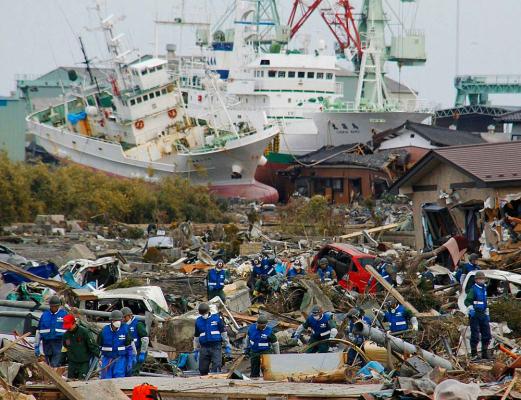The Oregonian has published another great article about the proposed Jordan Cove LNG export terminal, this time focusing upon the hazards in the event of an “inevitable” 9.0 earthquake.
Experts maintain that a mega-thrust earthquake off the Oregon coast is not simply a possibility, it’s inevitable. In fact, it’s overdue. Historically such quakes have recurred every 240 years, with the last one 314 years ago.
“It should be an assumption that this will happen during the lifetime of the facility,” said Chris Goldfinger, a seismologist at Oregon State University and leading authority on subduction zone earthquakes. “You can engineer anything to survive anything if you put enough money into it, but I’ve seen a lot of very well-engineered stuff destroyed as if it were Legos.”
The article quotes Jordan Cove project manager, Bob Braddock, who insists the plant will survive anything and contain all hazards within its property borders. He further maintains that a tanker would also be protected within the slip by three tractor tugs in the event of a tsunami. Not all experts agree.
The maximum wave height modeled in Jordan Cove’s tsunami study was 36 feet at the north end of the tanker slip. Combined with potential subsidence of 13 feet, the tanker could be bobbing in a run-up of almost 50 feet. Lesser scenarios still showed a combined run-up at the north end of the slip of nearly 30 feet.
That’s a massive and very sudden surge, one potentially full of debris. And it’s not clear how a tanker would fare — even a double-hulled tanker that affords additional protection to the cargo tanks.
Braddock says the storage tanks and other structures would divert a tsunami coming over the North Spit around the tanker slip. The wave affecting the slip would be the one that comes up the shipping channel, which would hit the tanker on the bow.
“We don’t see a situation where the tanker is forced out of the slip,” Braddock said. “If anything, it keeps it within the slip but not exactly the way we thought it would.”
Zhang’s study does not reach that conclusion, and the Coast Guard doesn’t analyze tanker security in a tsunami.
“I’m very skeptical that anything can be done in a near-shore tsunami” to protect the tanker,” said Randy Clark, a security specialist with the U.S. Coast Guard. “There simply isn’t enough time. … There are no real regulations. There is no requirement to mitigate this risk.”
Read the entire article here http://www.oregonlive.com/business/index.ssf/2014/06/coos_bay_lng_terminal_designed.html#incart_river




After reading the comments on the SCCF story linked in the article, this one sums it up well.
“Instead of clarity and accountability, the locally elected officials stretch the envelope of greed, chutzpha, and arrogant public disregard by willfully making the “enhancement” process as obtuse and confusing as possible. This, of course, is under the pretense of protecting the potential increased tax revenue stream from “unfair” distribution by evil entities from afar.
What on earth could possibly be fairer and more equatable than forming a non-profit shell corporation with private partners, appointing good-ole-boy buddies to the board, writing the bylaws on the back of a napkin, and remaining exempt from public scrutiny? ”
Our local leaders are very fortunate that we only have one local paper and it still is one of the cronie entities protecting these people. Its not hard to connect the dots between all these paid-off entities and Jordan Coves inserted lobbies. If fact they must be having a hard time keeping their eyes shut this tight.
Does Braddock actually believe that people, other than his politician pals, buy his crap? You may have heard that the Port has cooked up another deal with JCEP to pay for widening and deepening the channel. The press release from Ruby Red Shoes says that widening and deepening is not required by LNG vessels – it’s a way to help others including all the industry that will be coming to the North Spit to sit next to a LNG factory. Bullshit!!!! The vessels need greater depth. The turning basin needs width. And, when the coastline sinks six feet, this will increase volume and velocity of tsunami up the channel carrying many of the destroyed homes now situated along Cape Arago highway including the Opitz home – and that’s only fair as he was one of the most vocal advocates of the harmless ticking bomb. I’m waiting for The World newspaper to tell us why the CEP team, negotiating rom a position of strength, negotiated such a crappy deal with JCEP.
This question was in the article.
“Why here? Coos Bay is an industrial port. Its leaders welcome the economic development opportunity, while other communities along the west coast have rejected LNG terminals.”
That’s a true statement, these leaders, most of who are government employees drawing a pay check from our taxes, have been working for this for more than ten years. How did they get away with this betrayal to the safety and happiness of its local citizens that will have to live with the results of their efforts? The answer to that question is, they don’t care about the people who live here and the potential money has them all corrupted. Its a form of blindness that has stricken this area’s business community with the same virus. The only vision they have left looks like this $$$$$$$$$$$.
Yes, that was absolutely the best line in the whole piece and completely characterizes the 19th century mindset of the local power brokers.